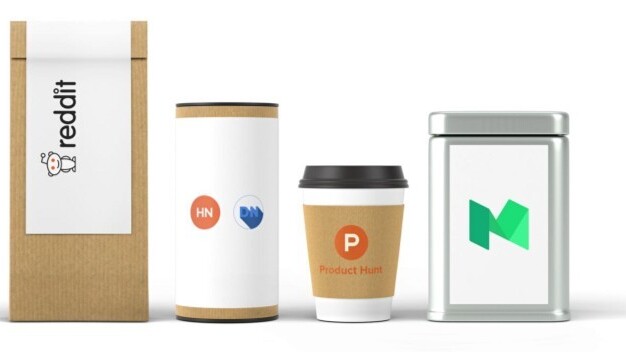
Over the next few years, there is no doubt content and attention will continue to shift from tens of millions of web sites to a few centralized networks that people access via apps on their phones. — Ev Williams
And in Ev’s words, those tens of millions of websites are the “loosely connected islands” that few people know how to optimize.
Today, instead of visiting our loosely connected individual website, an increasing number of people look for answers on Quora, pictures on Instagram, videos on YouTube, slides on Slideshare, or articles on Medium.
And such centralisation isn’t only happening across different content verticals. People tend to group around certain topic areas, too.
Thousands of design passionates meet on Designer News, inbound marketers on Inbound.org, tech geeks on Hacker News, product people on Product Hunt, or growth marketers on Growth Hackers. And the endless list goes on, to Reddit and all the others.
And in such a world full of “centralized networks,” a writer is able to attract 31,204,577 views simply by answering other people’s questions on Quora.
Or a homeless guy can become so famous on Vine, that when he organizes a meetup in Brazil, the riot police are called in to quell the crowd of thousands.
Today, an increasing number of businesses dedicate significant marketing resources to manage those distribution networks actively.
Indeed, those centralised networks have become so powerful that there are now even businesses like Panda or Muzli that solely focus on curating all those networks in one place.

The power of centralized networks
One of the most striking things about those networks is the incredible amount of traffic they bring to your online business.
This is an era where one upvote/recommend/thumbs-up on a centralised network like Hacker News can easily drive a few hundred visitors to your website.
Let’s take a look at some examples to see what this means for business.
Below are some of the things that happened right after I published one of my last Medium posts, “Side Project Marketing is The New King”:

Most centralised networks serve as a “discovery platform” where people make regular visits to discover “new cool stuff” in one place.
And those people who have just found that new cool stuff share it on other networks, leading to a potentially infinite viral loop.
The flow is pretty simple:
- Every passing second, thousands of crowdsourced links are submitted on those centralised networks by the community.
- The community then rewards the best content with upvotes or thumbs-ups, where each additional upvote brings up to a few hundred more views on the submitted content.
- The most upvoted content slowly floats to the top and once it hits the front page, each additional upvote, which used to initially drive only a few hundred views, now becomes a traffic machine and brings a few thousand additional visitors.
- Congratulations, your content just found the right loop. It’s now time you reach audiences you would never imagine reaching on your loosely connected island.
Here is another example from an article we published just a few days ago — “How we’re designing Dream Crew”:

And instead of hoping or waiting for other people to submit your content to those networks, you can submit it yourself and use those centralized networks to your advantage.
If you are just beginning…
or don’t have an audience who will help you gain momentum on those networks, here are a few tips that might help:
1. Remember you can always spend as little as $5–$10 on Facebook or other ad services to send visitors to your content. And don’t forget you’re doing this to give your content a chance, to see if it will pick up — good content will, and spending a fortune won’t help bad content. If you’re lucky, this will be enough for your content to gain momentum and it might even make it to “staff picks” depending on the network.
2. If you still don’t have a “gang,” you’re probably missing 90 percent of what’s really going on behind the scenes. By gang, I mean a group of friends and teammates who constantly support you by sharing or upvoting each other’s stuff. Ask your gang to show some love, but keep it with only a few friends and never explicitly ask for upvotes on any network (but do ask for feedback).
3. While those networks represent a huge opportunity, we, the marketers, have the reputation of ruining everything by exploiting every single bit of any opportunity. Try to game the system and some networks will put your IP on the blacklist forever, or downgrade and punish your content immediately. Again, you’re doing this to give a chance to your content — good content will pick up, but even an army of bots won’t help bad content.
4. When asking your gang to show some love to your content, never send them the direct URL. Unusual traffic from the same direct URL might spark an alert and get you blacklisted. Ask them to search for and find your content on those networks on their own.
5. Some networks allow multiple submissions of the same link, and indeed, sometimes it takes submitting the same link a few times before it gets traction.
6. Submitting your content to as many relevant networks as possible works in most cases. Below I picked some of the random networks that have been driving significant traffic to the articles we’ve published in #SWLH:
(Note: If you’re using networks like Reddit, never underestimate the power of sub-channels such as reddit.com/r/programming or reddit.com/r/web_design or reddit.com/r/webdev)

Those centralised networks have grown so much in number and scope that we need to realise distributing content isn’t only about sharing a blog post on Facebook and Twitter in hopes of getting some likes or retweets.
It turns out content and attention will continue to shift from tens of millions of web sites to a few centralized networks. And it’s time we start making good use of these networks.
Read next: How to grow your startup with no budget
Get the TNW newsletter
Get the most important tech news in your inbox each week.




